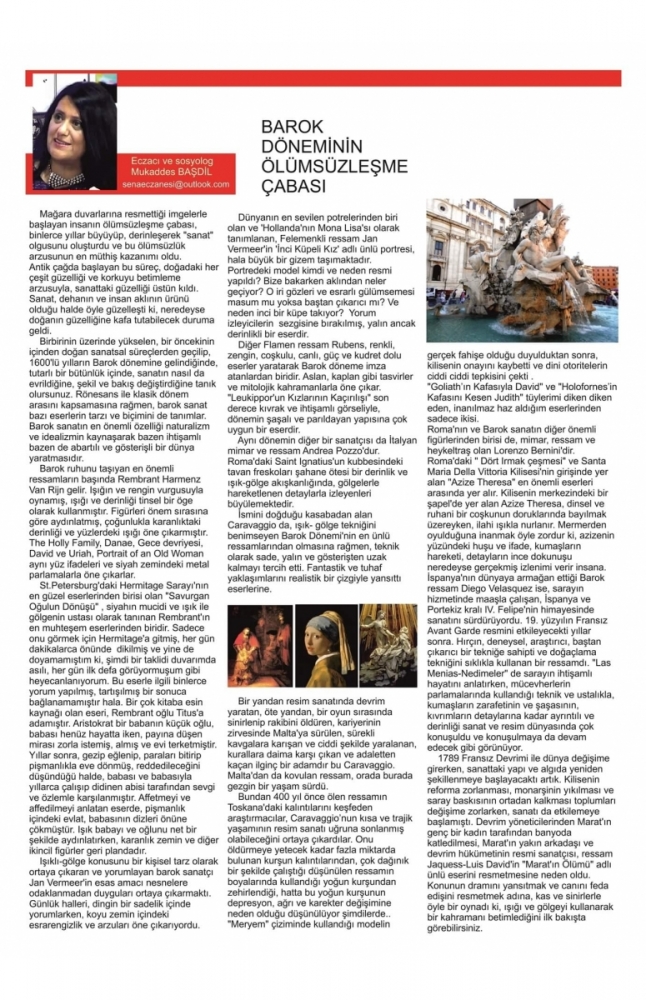No products

THE BAROQUE PERIOD'S EFFORT TO IMMORTALIZE
Starting with the images painted on the cave walls, man's effort to become immortal has grown and deepened for thousands of years, forming the phenomenon of "art", and this immortality has been the greatest achievement of the Dutch painter Jan Vermeer, one of the most popular portraits in the world and described as the "Mona Lisa of the Netherlands". Vermeer's famous portrait, 'Girl with a Pearl Earring', is still a great mystery. was it painted? Who was the model in the portrait and why did the desire to depict every kind of beauty and horror in nature, a process that began in antiquity, made beauty in art superior. Although art is the product of genius and human intellect, it has become so beautiful that it can almost challenge the beauty of nature. Are her big eyes and enigmatic smile innocent or seductive? And why is she wearing a pearl earring? It is a simple yet profound work, the interpretation of which is left to the viewer's intuition. When the Baroque period of the 1600s is reached, you witness how art evolves, changes shape and perspective in a coherent whole, through artistic processes that rise above each other and arise out of the previous one. Although it covers the period between the Renaissance and the classical period, baroque art also defines the style and form of some works. The most important characteristic of baroque art is the fusion of naturalism and idealism, creating a world that is sometimes magnificent and sometimes exaggerated and ostentatious. Rembrant Harmenz Van Rijn is one of the most important painters carrying the Baroque spirit. He played with the emphasis of light and color and used light and depth as a spiritual element. He illuminated the figures in order of importance, mostly emphasizing the depth in the darkness and the light on the faces. The Holly Family, Danae, Night Patrol, David and Uriah, Portrait of an Old Woman, The Holly Family, Danae, Night Patrol, David and Uriah, Portrait of an Old Woman are characterized by the same facial expressions and metal flashes on a black background. "The Return of the Prodigal Son", one of the most beautiful works in the Hermitage Palace in St. Petersburg, is one of the greatest works of Rembrant, known as the inventor of black and the master of light and shadow. I went to the Hermitage just to see it, stood in front of it for minutes every day and still couldn't get enough of it, and now a reproduction of it hangs on my wall, and every day I get excited as if I'm seeing it for the first time. Thousands of comments have been made and discussed about this work, and still no conclusion has been reached. Rembrant dedicated the work, which inspired many books, to his son Titus. The younger son of an aristocratic father, while his father was still alive, demanded his share of the inheritance by force, took it and left home. Years later, he returned home with regret after traveling and having fun, spending the money, and although he thought he would be rejected, he was welcomed with love and longing by his father and his older brother, who had worked and toiled with his father for years. In the work about forgiveness and being forgiven, the remorseful son falls to his father's knees. The light clearly illuminates the father and son, while the dark ground and other secondary figures are in the background. The main aim of the baroque artist Jan Vermeer, who created and interpreted light and shadow as a personal style, was to reveal emotions without focusing on objects. While interpreting everyday situations in a serene simplicity, he emphasized the mysteriousness and desires in the dark background. Rubens, another Flemish painter, is one of the signatures of the Baroque period by creating colorful, rich, exuberant, vibrant, full of power and might. He stands out with depictions such as lions, tigers and mythological heroes. "The Abduction of the Daughters of Leukippor", with its extremely agile and magnificent visuals, is a work very suitable for the glittering and shining structure of the period. Another artist of the same period was the Italian architect and painter Andrea Pozzo. His ceiling frescoes on the dome of Saint Ignatius in Rome fascinate the viewers with a marvelous depth and fluidity of light and shadow, with details that move with shadows. Caravaggio, who took his name from the town where he was born, was one of the most famous painters of the Baroque Period who adopted the light and shadow technique, but he preferred to remain technically simple, plain and unpretentious. He reflected his fantastic and bizarre approaches with a realistic style. Caravaggio is an interesting man who, on the one hand, revolutionized the art of painting, on the other hand, got angry during a game and killed his opponent, was exiled to Malta at the peak of his career, was constantly involved in fights and seriously injured, always defied the rules and escaped justice. The painter, who was also expelled from Malta, led a wandering life here and there. Researchers who discovered the remains of the painter, who died 400 years ago in Tuscany, have revealed that Caravaggio's short and tragic life may have ended for the sake of painting. It is now thought that the painter, who is thought to have worked in a very disorganized manner, was poisoned by the intense lead he used in his paints, and even that this intense lead caused depression, pain and character change... After it was announced that the model he used in his "Mary" drawing was a real prostitute, he lost the approval of the church and attracted a serious reaction from religious authorities. "David with Goliath's Head" and "Judith Beheading Holofornes" are just two of his works that gave me goosebumps and gave me incredible pleasure. Another important figure of Rome and Baroque art is Lorenzo Bernini, architect, painter and sculptor. Among his most important works are the "Fountain of the Four Rivers" in Rome and the "St. Theresa" at the entrance of the Church of Santa Maria Della Vittoria. Located in a chapel in the center of the church, St. Theresa was about to faint at the height of religious and spiritual ecstasy when she was illuminated by divine light. It is so hard to believe that it is carved in marble, but the awe and expression on the saint's face, the movement of the fabrics, the delicate touch of the details give the impression that it is almost real. The Baroque painter Diego Velasquez, Spain's gift to the world, was working under the patronage of Felipe IV, the king of Spain and Portugal, who worked for a salary in the service of the palace. Years later, he would influence 19th century French Avant Garde painting. He had an aggressive, experimental, investigative, seductive technique and was a painter who often used improvisational techniques. While depicting the magnificent life of the palace in "Las Menias - The Bridesmaids", the technique and mastery he used in the shining of the jewels, the elegance and splendor of the fabrics, the detail and depth of the folds were talked about a lot in the art and painting world and it seems that it will continue to be talked about. With the 1789 French Revolution, as the world was undergoing change, the structure and perception in art would begin to be reshaped. Forcing the church to reform, the overthrow of the monarchy and the disappearance of palace oppression forced societies to change and began to affect art. The assassination of Marat, one of the leaders of the revolution, by a young woman in the bath led the painter Jaquess-Luis David, Marat's close friend and the official artist of the revolutionary government, to paint his famous work "The Death of Marat". In order to reflect the drama of the subject and to portray the sacrifice of his life, he played with muscles and nerves in such a way that you can see at first glance that he is using light and shadow to depict a hero.

